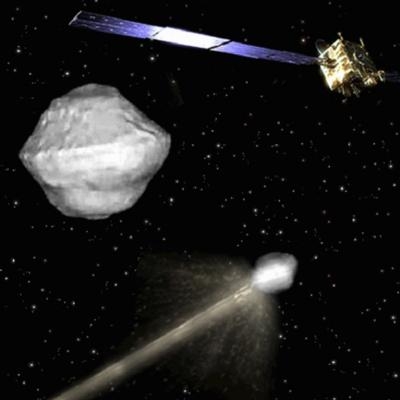Fri, Jan 18, 2013
Seeking Improved Understanding Of High-Speed Collisions Between Natural And Man-Made Objects
A space rock several hundred metres across is heading towards our planet and the last-ditch attempt to avert a disaster – an untested mission to deflect it – fails. This fictional scene of films and novels could well be a reality one day. But what can space agencies do to ensure it works?

ESA is seeking research ideas to help guide the development of a US–European asteroid deflection mission now under study.
Concepts are being sought for both ground- and space-based investigations, seeking improved understanding of the physics of very high-speed collisions involving both man-made and natural objects in space. ESA’s call will help to guide future studies linked to the Asteroid Impact and Deflection mission – AIDA. This innovative but low-budget transatlantic partnership involves the joint operations of two small spacecraft sent to intercept a binary asteroid. The first Double Asteroid Redirection Test (DART) spacecraft, designed by the US Johns Hopkins Applied Physics Laboratory will collide with the smaller of the two asteroids.
Meanwhile, ESA’s Asteroid Impact Monitor (AIM) craft will survey these bodies in detail, before and after the collision. The impact should change the pace at which the objects spin around each other, observable from Earth. But AIM’s close-up view will ‘ground-truth’ such observations. “The advantage is that the spacecraft are simple and independent,” says Andy Cheng of Johns Hopkins, leading the AIDA project on the US side. “They can both complete their primary investigation without the other one.”
But by working in tandem, the quality and quantity of results will increase greatly, explains Andrés Gálvez, ESA AIDA study manager: “Both missions become better when put together – getting much more out of the overall investment. “And the vast amounts of data coming from the joint mission should help to validate various theories, such as our impact modeling.”
(ESA image artist's concept of AIDA mission)
More News
Aero Linx: The American Society of Aerospace Medicine Specialists (ASAMS) The Society is a non-profit organization created to serve as a voice for and represent the professional ne>[...]
Class C Service This service provides, in addition to basic radar service, approved separation between IFR and VFR aircraft, and sequencing of VFR aircraft, and sequencing of VFR a>[...]
Have A Story That NEEDS To Be Featured On Aero-News? Here’s How To Submit A Story To Our Team Some of the greatest new stories ANN has ever covered have been submitted by our>[...]
Also: ERAU Uses UAVs, P550 Group 2 UAS, Starship’s Florida Launches, NASA Missions Chopped The Air Force has put out a call to commission a one-to-one copy of the Iranian-des>[...]
Classic Klyde Morris From 11.07.16 (and Remembering Bob...) FMI: www.klydemorris.com>[...]
 ANN's Daily Aero-Linx (08.27.25)
ANN's Daily Aero-Linx (08.27.25) ANN's Daily Aero-Term (08.27.25): Class C Service
ANN's Daily Aero-Term (08.27.25): Class C Service ANN FAQ: Submit a News Story!
ANN FAQ: Submit a News Story! Airborne-NextGen 08.26.25: Iran UAV Knockoffs, X-37B Spaceplane, Army Training
Airborne-NextGen 08.26.25: Iran UAV Knockoffs, X-37B Spaceplane, Army Training Classic Klyde Morris (08.25.25)
Classic Klyde Morris (08.25.25)



